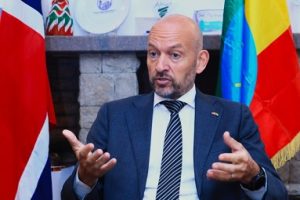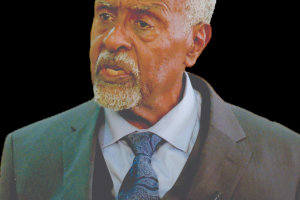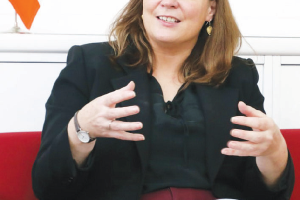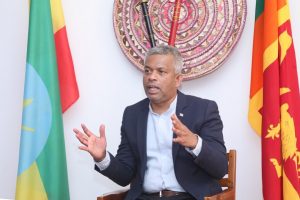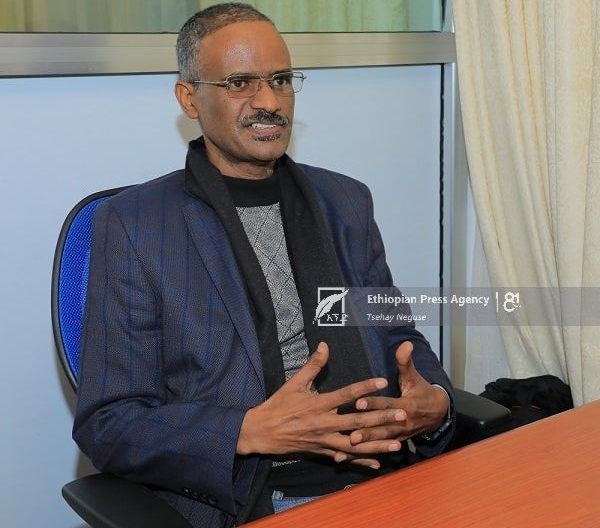
BY ZEKARIAS WOLDEMARIAM
Today’s Herald Guest presents Zenebe Desta (PhD). Zenebe is a journalist and communication adviser by profession. He has years of experience in various media including Ethiopian News Agency and Walta Information Center. After moving to humanitarian agencies, he has worked in communication field for Action Aid and Save the Children. Then, he joined the United Nations to work for the Mission in South Sudan as a Public Information specialist for four years. Zenebe showed inclination towards conflict sensitivity as he has worked in peace building area and has pursued his higher study in the area related to conflict sensitive reporting.
In his Doctoral dissertation Zenebe has scrutinized the practice of conflict sensitive reporting by comparing the reports of The Ethiopian Herald on the series of negotiations on GERD with the reports of Egypt’s Ahram Online on similar issue within the same period. His findings have shown that the Ethiopian Herald has shown more sensitivity towards conflict than Ahram Online.
Acknowledging his effort to study The Ethiopian Herald’s success in handling the controversial issue of GERD talks responsibly, we have interviewed him in detail about the study as well as the role of media in becoming conflict sensitive in their reporting than engaging merely on war reporting. Enjoy reading!
To begin with, could you explain what conflict sensitive reporting is compared with war reporting?
Yeah. Basically reporter reports what he/she chooses on behalf of the public. But when it comes to reporting on conflict, there needs to be extra care. There are principles of journalism, which are independence, fairness, humanity, impartiality; all implicitly tell what you need to do when practicing to cover conflict. There are seemingly opposing trends, one is the traditional journalism way of covering conflict which is also known as war journalism. The other is an evolving conflict sensitive reporting or peace journalism. There is squabble between the two conceptual formations.
The previous asserting that journalist represents objectivity the truth they experienced. On the other hand the strong proponents and veteran journalists Lynch and McGoldrick argues that when editors and reporters selects what and how to report an issue, objectivity will be in question and bias ensues. Selection and making particular reality outstanding likely take away objectivity. This is specifically vivid when it comes to conflict, because human beings have lineage to certain affiliation or under the influence of the media’s ownership among others.
There are significant disparities when we compare conflict sensitive reporting and the traditional way of coverage of conflict or as some say war journalism. To mention some, conflict sensitive reporting concentrates and looks on issues satisfying the interests of all parties while the traditional one tend to upholds win/lose attitudes in its coverage like reporting soccer match. Conflict sensitive reporter minimizes polarity and emphasizes agreement but war journalism illuminates differences that polarize parties to conflict ending up adding fuel to fire. Conflict sensitive media give platform for more open discussion as well as promote issues of building trust. But traditional journalism distance or constricts dialogue and discussions focusing on fanning the afflicted relation of the parties.
It is also good to cite here the often mentioned example of the 2008 and 2013 elections. Media became conflict sensitive in the coverage of the general election in 1913. That was because media personnel were oriented on the conflict sensitive reporting from the learning of 2008, as over thousand people were killed for reasons attributed to the inflammatory role of the news media. Then, in the next election (2013) the media bypassed the nonconformity of election rules and the practice of manipulation for fear of violence. Sensationalized coverage contributed for the peril which is the characteristic of traditional media handling conflict. Later, the media after orienting themselves with conflict sensitivity, done better in their handling of the sensitive issue but still not ethical to hold back facts of irregularities of the process.
How do you explain the drawbacks traditional journalism reporting of conflict?
When conflict starts there is latent conflict that we don’t see because it is embedded in the culture. It is entrenched in the structures. One day, it manifests itself and become violent conflict when not addressed. Traditional journalism does not dare to do analysis of conflict to help dig into embedded conflict and contribute to settling conflict. The other important principle of conflict sensitive journalism is not to perceive conflict as zero-sum game or seeing conflict as battle between two parties or tug-of-war in which one losses and the other wins. Sourcing predominantly elite translates to anchoring to position or representing only what is chosen and spoon-fed without bothering to look the other sides is also the drawback of traditional journalism in the face of conflict coverage.
The excessive portrayal of divergence by news media also implicitly promotes ‘win-loss’. The loser may not remain as such and look ways around. Parties might also opt or forced to ‘loss-loss’ scenario by backing away temporarily from their incompatible goals. Both these scenarios are not bringing sustainable and real solution for the conflict. Reporting such scenarios of conflict as they happen may need limited effort. It doesn’t need bringing in analytical skill but exposes the media personnel to personal bias.
Coming to the context of our country, we have a series of conflicts in the last couple of years. So, how do you see it, escalating or de escalating conflict?
It is ideal we see the concept of conflict through the eyes of a sociologist and pioneer of peace and conflict theory of Johan Galtung. His perception of conflict is from three perspectives – direct, structural and cultural. He positions them in a triangle also dubbing it ‘conflict triangle’. This is one of the tools of conflict analysis as conflict onion does. At the top is direct conflict. It is an action of violence be it physical or verbal and is exemplified by mob and terrorist attack, hate speech, torture and so forth. In this case, the perpetrators and victims causing physical and psychological injury or property damage are clearly visible.
Structural and cultural conflicts are at the wider part of the triangle and are subtler. Structural violence is the one built into the laws and tradition of society are injustice, discrimination, the denial of basic rights, non-recognition of the rights of minority, practices of colonialism and slavery, inequality of women, etc. It might be difficult here to identify specific perpetrator.
Cultural violence on the other hand is a way a group assumes about another which is attitudes, norms, values and beliefs that perpetuate the other two, direct and structural violence. All these three reinforce each other.
Looking to our scenario, it may seem that there was no much apparent violence or the direct violence before. However, it can be said that it is complex, sitting deeper in the structure of the society and the system. As I understand, the direct violence prevalent now or since few years is because of the manifestation of what is built in the structure. It can be also said the direct violence become apparent when one going for perpetuating and the other to change or recertify.
Can you tell us about your study and finding?
I was inspired by my previous activity, while working in UN. I every so often times managing coverage because I was in conflict prone place. So, I started to see back literature in the area of conflict and the media after completing my term. I picked out conflict onion among other conflict analysis tools to experiment its applicability and to contribute to the model of conflict sensitive reporting which in turn help deepen the analytical skills of journalist covering conflict.
The issue of ownership and institutional makeup all have add up to complexities and challenges on how conflict is reported. So, there is an assumption that usually government owned media or government sponsored media are only taking the position of the owners. Thus, I have set out to take three media comparatively operating in similar scenario, each one from Ethiopia, Sudan and Egypt. However, dropped the inclusion of news media from Sudan, as there was no government owned English edition at that point in time. Two months of samples (June and July 2020) on the coverage of GERD negotiations which also coincides with significant milestone of the GERD project was selected and as it was the filling of the first round. In this seemingly seasonal kind of focus of media, there are 118 coverage or reports on the issue of GERD by The Ethiopian Herald and 103 by Ahram Online.
Actually, I should have checked whether this media have taken some kind of orientation or training on conflict sensitive training but that was not realized because of an unforeseen challenge. All issues of coverage of negotiations on GERD has been taken covering all the dates of June and July 2020 and seen from three perspectives. One is sourcing of news and the other is emphasis on issues of common ground which is what these countries have in common with regard to this natural resource and finally the treatment of issues at variance or issues they have at odds.
Understanding of the context, the cause of the dispute, the actors’ interests and the dynamism of the time in the three countries and the Nile Basin in general was part of the review during the study. This has something to inform us. In the utilization of the water resource, trapping oneself in the status quo and cursing those moving to assert basic rights will not yield sustainable solution. You may hear and read loads of advice of experts that there would be ensuing water shortage because of population growth, economic development and climate change. Thus, redirecting focus in relieving this potential water crisis through strategies of water conservation, economic cooperation, trade and technological adoption is the preferred means.
In sourcing coverage, the finding point to none diversified voices by Ahram Online with event focused reproducing mainly position taking the whole lot of over 97 percent compared to 50 percent by The Ethiopian Herald. A good share was given for diversified voices to be entertained by The Ethiopian Herald.
The second is the search for common ground approach which is also more represented by The Ethiopian Herald, about 24 against 15 by Ahram Online. This is the other core concept to be pursued by representing what parties can have in common and what the ordinary citizens could benefit when cooperating for mutual benefit including showing a way for all to win.
Lastly, the study showed that coverage that plays role of escalation of conflict is more exhibited by Ahram Online, about 35 percent as compared to 11. This concept is contrary to the previous, driving the latent status of conflict to violence.
What does the conflict onion theory or peeling the onion tell us about conflict and their settlement?
Conflict sensitivity is an approach to ensure interventions do not contribute to conflict. Conflict onion is a metaphor going step by step to reach to the hidden inner parts. This tool helps to disclose the concealed constituents critical in resolving a conflict. Peeling the onion in conflict sensitive reporting is to go beyond what is readily seen and consider these inner facets and traits to bring to light which are fundamental in contributing to addressing conflict. Taken from conflict analysis theory, this analogy will help deepen the analytical skill of journalist in covering conflicts by reaching to the common ground of parties and representing diverse articulation instead of resorting to simplicity and restating familiar demands and statements. Conflict analysis takes into consideration of context, cause, stakeholders and dynamism of the time which is also applicable to conflict sensitive reporting.
Media that goes deeper can reach to the issues satisfying the interests of all parties and become a vehicle in initiating creative solutions. A reporter analyzing conflict minimizes polarity and emphasizes agreement serving as a vehicle of building relationships and understanding. A reporter peeling the cover can find points of co-operation of the conflicting underneath rather than those covering and the confrontational. Such actions motivate parties for more open discussion and promote issues of building trust and reducing uncertainty. We know there were conflicting parties who sat for discussions with the conflict sensitive approach of the media. Media can become a vehicle to seeing the conflict differently and discovering different solutions. These all are their positive role in contributing for conflict settlement. Media is also duty bound to contribute for settlement of conflict at its latent stage that is before it turns violent and cause for great deal of threat for all.
So can you also feel we can replicate this conflict sensitive reporting experience of The Ethiopian Herald to several sections in our country?
Conflict sensitive reporting has its traces as per the sample study. If not, we are late in the sense that some Asian countries have already on the way in integrating it into the curriculum, introducing the concept. There are networks of journalists trying to come together and promote this kind of reporting. So, it is important even for relevant media institutions to look into this and integrate into the school curriculum, because you have to go with developing contemporary concepts for of the society.
There need to be awareness that journalism is not just reporting and distributing facts but also taking responsibility for the harm this might cause. This concept needs to be inculcated into the minds of forthcoming generation. Networking and sharing from other countries experience on how it has been going can also help. I think we don’t have shortage of academicians. So, it’s high time to consider the concept of conflict sensitive reporting, so that to practice good journalism for the good of the society.
With regard to the study result serving as an example, I took only samples from The Ethiopian Herald among the news media in the country other than that of Egypt to see where it is positioned from the perspective of conflict sensitive coverage. There could be other media here wittingly or unwittingly exercising this. The case of this newspaper obviously gives us a good example that though dealing which national issue at same time owned by government seems testing during conflict over GERD, it specifically demonstrated that it is possible to include diversified voices on issues of conflict than repeating the official statements and The Ethiopian Herald has a nobler practice of conflict sensitivity worth replicating.
Ethiopia is set to hold an inclusive national dialogue in the near future to wind up the protracted conflict in the country. How do you think should the media approach in its reporting?
As an instrument of peace building and conflict management, dialogue need to be supported by media. The media is believed to help the National Dialogue Commission to comprehend interests of the public as well as enhance communication for the commission to be effective.
During the intended inclusive dialogue, media is expected to play fundamental role in serving as a platform for debt and expression of perspectives. It needs to be a channel for shading light on issues of the dialogue and its process as well as present the ambition of diversified groups and also countering polarization and hegemony.
Conflict sensitive media should be cautious not to become the victim of subtly designed media strategy for covering up truths and becoming a propaganda tool which are not helping the efforts of the dialogue. The long sought initiative and the move of parties and groups for dialogue on its part enhances the role of media in peace building. This will be possible when it unrelentingly work to give voice for the suffering of people from all sides due to the conflict and also feature in its coverage those on the side of peaceful measures and speaking out against violence.
Thank you very much for your time
Thank you
The Ethiopian Herald July 23/2022

